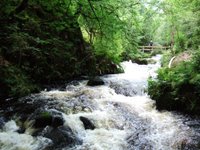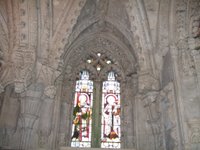
The sunshine returned today, and we made the most of the day. The first stop was Falkland: a very attractive town, with a most interesting
Palace; the royal holiday home when James V and Mary Queen of Scots were around. James married a French wife, and he had the first tennis court in the UK built in his back yard. Coming long before Lawn Tennis it has a different court layout and different rules to the modern game. Similarities are a ball, a racquet and a net, but not much else: the spectators’ gallery roof is part of the paying area. ‘Real Tennis’ is still played on this court.

In our search for the perfect formal gardens we called at
Kinross Gardens: they were lovely, but the quest was not satisfied until the end of the day.

Nearby was
Culross: an amazing village where it feels like being in a time warp. Buildings dating back to 16th and 17th centuries have been restored by the National Trust for Scotland.

Unfortunately the Bishop's Palace, Abbey and Study were not open.

We then drove to Falkirk, as we had seen an article regarding their
Millennium Wheel. This is a huge wheel which raises one barge to a high canal, and at the same time lowers the barge already at the top: a very spectacular piece of modern engineering.

Next stop was Stirling, to look at the
castle. This is a huge castle on a strategic promontory. It was home to the Kings of Scotland, and is currently undergoing renovation. The feature we liked best, was watching two weavers at work, they are currently making the third tapestry of a series of six, to hang in the Queen's bed- chamber. The modern tapestries are so colourful, but to see the weavers working on one was very interesting.
En route from Stirling Castle to Drummond Castle we made a quick stop in Alva from where Christine's forebears left when they emigrated to NZ.
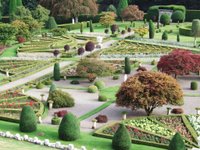
Alva was, as her ancestors had decided, a good place to leave, so we pressed on to our final stop for the day,
Drummond Castle Gardens. Having seen a brochure, we thought they looked rather special. The drive in set the scene: a very long, narrow, tree-lined driveway led to the Castle. The old and new castles are built side by side, and below them is a huge formal garden. It is magnificent: we had finally found the best formal garden in the UK.

 The annual London open weekend this year enjoyed beautiful late summer sunshine.
The annual London open weekend this year enjoyed beautiful late summer sunshine.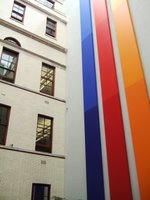
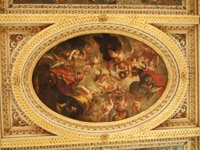
 For us no open weekend would be complete without visiting a livery company and true to form we saw three over the weekend. The Vinters’ Hall and Apocatheries’ Hall both have very handsome buildings that date back to the Great Fire of London. As a contrast the Haberdashers’ building was only opened in 2002: their previous building being one of the casualties of the Second World War.
For us no open weekend would be complete without visiting a livery company and true to form we saw three over the weekend. The Vinters’ Hall and Apocatheries’ Hall both have very handsome buildings that date back to the Great Fire of London. As a contrast the Haberdashers’ building was only opened in 2002: their previous building being one of the casualties of the Second World War.















